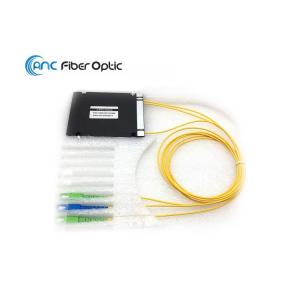Passive Optical Networks WDM PON Modules For GPON XGS-PON NG-PON2 OTDR
Add to Cart
Passive Optical Networks WDM PON Modules For GPON XGS-PON NG-PON2 OTDR
Description
Passive optical networks (PON) are the most attractive and
extensively studied solutions for optical access technologies.
Legacy GPON and EPON built with power splitter technologies are
currently deployed as high-speed and high-capacity optical access
technologies using time division multiplexing (TDM). All signals
are distributed through this optical network from the optical line
terminal (OLT) to every end user’s optical network termination unit
(ONT) connected on the same PON branch.
The next-generation NG-PON should satisfy demands for increasing
traffic and higher bandwidths. All future strategies for NG-PON
evolution are expected to deploy WDM. The candidate systems are
based on evolutionary growth. Current GPON systems are intended to
migrate to NG-PON applying identical colorless ONTs. The migration
would occur in the same optical distribution network which implies
coexistence. The advantage appears in cost saving, easier planning,
maintaining and expanding of this network. The evolutionary growth
under NG-PON is based on the demand of the minimal equipment
investments. NG-PON should operate with the same infrastructure as
GPON. However, coexistence should be supported by some preventative
measures to avoid interferences between downstream and upstream
channels of GPON and NG-PON. Therefore, current GPON and NG-PON
coexistence requires wavelength separation of signals assigned for
ONTs of GPON, 10 Gbit PON (called: XG-PON) and WDM-PON. Low-cost
WDM are required for the wavelength band separation to ensure that
GPON ONTs can operate undisturbed alongside NG-PON deployments.
Thin-film passive filters (TFF) are suitable low-cost,
ONT-independent (i.e. coexisting) and simple operation candidates.
We offeres a full range of xWDM products and this WDM-PON module is included in the range which meets GR-1209-CORE and GR-1221-CORE standard.
Specification
RoHS Compliant
High Stability and reliability
Epoxy-free on Optical Path
Easy planning for maintaining and expanding of network
Features
Telcordia GR-1209-CORE-2001
Telcordia GR-1221-CORE-1999
RoHS
Usage
GPON System
EPON System
WDM PON Networks
Technical Data
| Parameters | GPON/XGPON/ NG-PON2/ OTDR | |
| Center Wavelength (nm) | 1260-1650 | |
| Pass band (nm) | GPON | 1290-1330& 1480-1500 |
| XGS-PON | 1260-1280&1575-1580 | |
| NG-PON2 | 1524-1544& 1596-1603 | |
| OTDR | 1625-1650 | |
| Insertion Loss(dB) | COM ↔ GPON | ≤0.8 |
| COM ↔ XGS-PON | ≤1.2 | |
| COM ↔ NG-PON2 | ≤1.4 | |
| COM ↔ OTDR | ≤1.2 | |
| Isolation(dB) | GPON@XGS-PON/NG-PON2 | >30 |
| XGS-PON@GPON/NG-PON2 | >45 | |
| NG-PON2@XGS-PON/GPON | >45 | |
| OTDR | >15 | |
| PDL(dB) | ≤0.2 | |
| RL(dB) | >48 | |
| Directivity(dB) | >50 | |
| Fiber Type | SMF-28e or customer specified | |
| Maximum Optical Power (mw) | 300 | |
| Operating Temperature (°C) | -10~70 | |
| Storage Temperature (°C) | -40~85 | |
| BOX Package(mm) | ABS: 100*80*10 | |
| LGX Package(mm) | 1U 130*150*28 | |
| 19’’ Rack mount Package(mm) | 1U 19” Rackmount | |
2. Values referenced without connectors and insertion loss for a connector-pair is 0.20dB (typ.) and 0.30dB (max.).
Related Pictures:



